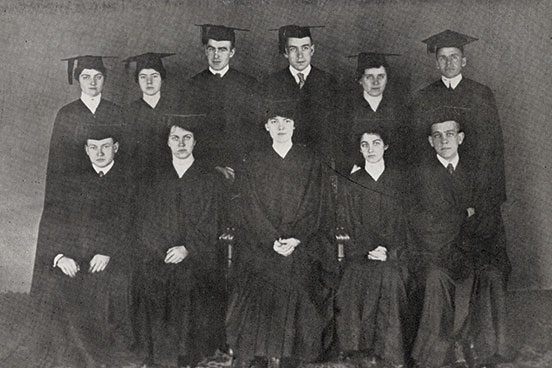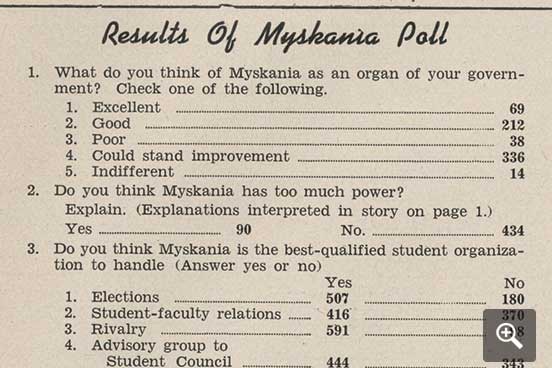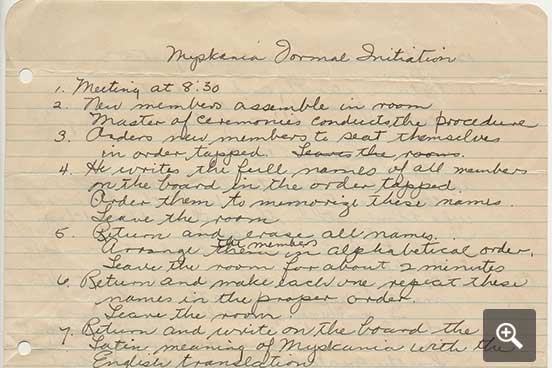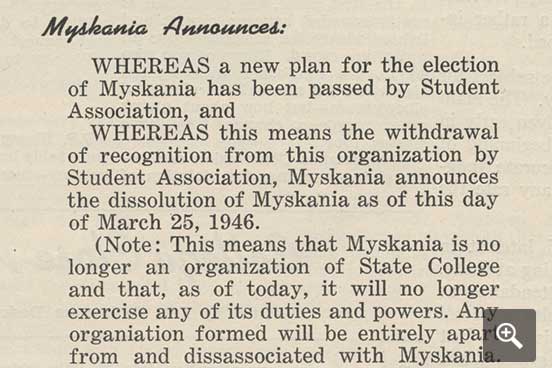
MYSKANIA 1917 from the yearbook, The Pedagogue
MYSKANIA Revealed
By Geoff Williams, University Archivist Emeritus
For the Fall 1991 Albany magazine, I wrote “Bring Back the Memories,” which described the rich Alumni Memorabilia Collection the Alumni House had recently donated to the University Archives. Among the records Alumni House turned over were the post-1946 papers of MYSKANIA, successor to the first student government created by the New York State College for Teachers Faculty Council in April 1917. In the article, I asked whether anyone could fill in the gaps about MYSKANIA. The original MYSKANIA dissolved on March 25, 1946, in a quarrel with the student body and the Student Association over the undemocratic nature of election to the organization – members chose their successors – and, to a lesser degree, its secrecy.
In 1946, students responded to a poll about MYSKANIA.
My request for additions to the collection brought a number of new acquisitions that helped us to explore and understand student life at the school. An important addition to our files arrived from Bernie Kerbel ’33, a former MYSKANIA member, in January 1992. He detailed the meaning of MYSKANIA’S Latin name, which, according to its original constitution, was supposed to remain secret, known only to initiates. Worried that the meaning of the name would be lost forever, Kerbel recalled the following as the elements contained in the acronym:
M = “Minerva”
Y = “iustidia” – “Y” for “I”
S = studien
K = “que” – “K” for “Q”
A = “ad”
N = “nostra”
I = “in”
A = “Alia” The word should probably have been "aulis."
Kerbel also provided a rough English translation: “Minerva, guardian of justice and students in the school’s halls.” (Item 7 of the handwritten graphic below offers alternative Latin wording and a different English translation.)
Pictured, from 1941, is the only existing example of the original MYSKANIA initiation ceremony, handwritten by Mary Elizabeth Miller Drake ’41 and donated by her daughter, Marsha Johnson. Note the slight difference in the Latin but general agreement on the English meaning of MYSKANIA.
Kerbel’s letter repeated the story that the first MYSKANIA burned all its minutes and constitutions when it disbanded in 1946. He stated that he visited with a successor MYSKANIA in the early 1960s and explained to its members the acronym’s original meaning. They told him their predecessors said MYSKANIA was an acronym for the New York State College for Teachers, with an “M” substituted for “N” in “New,” and a “K” for the “C” in “College,” while the “ANIA” stood for “at New York in Albany.” The outgoing 1946 MYSKANIA didn’t share the Latin meaning of the name, the ceremonies or past minutes with the recreated, democratic MYSKANIA elected in May 1946.
In the early 1990s, I believed the assertion – since proven incorrect – that the original MYSKANIA had destroyed all its records. Thanks to a 2006 donation we were required to keep secret for 10 years, we have fuller minutes of the first MYSKANIA than for the organization’s successor. The original MYSKANIA minutes were turned over to former chairman Michael Lampert ’73. While Lampert was on what he called a “friend-raising” visit to the Rochester area for the University’s Development Office in 1972, preparing for the inaugural SUNYA Annual Fund campaign the following year, he was approached by a former MYSKANIA member who gave him most of the organization’s missing pre-1946 records for safekeeping. Lampert turned them over to me in 2006, 60 years after the original MYSKANIA disbanded. The December 1944-March 1946 minutes remain missing.
MYSKANIA’s dissolution notice was published in the March 29, 1946, State College News.
MYSKANIA’s records are important because of the pivotal role the organization played at the New York State College for Teachers. It was the first student government, initially known as the Student Council, but at its second meeting in April 1917, members chose the name MYSKANIA. Prior to 1946, the organization was responsible for representing the student body before the faculty. Its members created and/or governed and changed school traditions (Rivalry, Moving-up Day, etc.), most of them retained until the move to the uptown campus in the 1960s. In 1921, MYSKANIA created and wrote the initial constitution for the Student Association, relinquishing its own leadership of student government. It approved the constitutions of Greek social and service organizations and clubs, including the State College News board and the Finance Board, and approved officer candidates for student-funded organizations (primarily making sure that candidates for office had paid the student tax). Finally, MYSKANIA served as the student judiciary.
As long ago as 1927-28, there was conflict between the original MYSKANIA and the Student Association, and the association’s 1945 constitution detailed why. The Student Association claimed the right to represent students before the Faculty Council and instituted direct election of MYSKANIA members, though, as MYSKANIA itself suggested, partially from a list of 10 students chosen by outgoing members. Over the decades, successive Student Association constitutions, paired with the changing nature of the college as it evolved into a university, whittled away MYSKANIA functions and powers. A greatly expanded enrollment; relocation to the uptown campus; and abandonment of such NYSCT traditions as Rivalry, which ended in 1963, were also factors.
By 1965, MYSKANIA’s judicial powers were gone; its last election was held in 1978. The Student Association refused to fund MYSKANIA’s ceremonial functions, and the organization ceased to exist in 1979. University President Vincent O’Leary was inspired in 1982 to embody MYSKANIA’s service aspects – for example, assisting at events and providing guides for high-school tours of the campus – in Purple and Gold.
MYSKANIA members, both pre- and post-1946, always selflessly supported their alma mater. To mention just two: Eunice Baird Whittlesey ’44, president of the Alumni Association during the construction of the Alumni House, also spearheaded the campaign to create the Veterans Wall of Honor, dedicated in 2001. After graduation, former MYSKANIA Chairman Michael Lampert ’73 immediately joined the Alumni Association Board of Directors, serving even while he was in law school and studying for his bar exams. He subsequently became the association’s treasurer, then president. Lampert’s longtime support of Rockefeller College has included funding student scholarships.
The Life and Death of MYSKANIA, written by Alfred Basch ’31 and published in 1984, offers more detail about the organization’s history. While writing his excellent work, Basch – unaware the 1917-44 MYSKANIA records existed – relied on student-newspaper accounts. Now, the minutes and records from 1917-78 are available in the University Archives. A few gaps remain: There are no minutes of the original MYSKANIA from December 1944 until its dissolution in 1946, from 1952-53, and from 1964 through 1979.
Please contact University Archivist Gregory Wiedeman if you have records to add to UAlbany’s MYSKANIA holdings. He can be reached at [email protected] or 518-437-3936.






